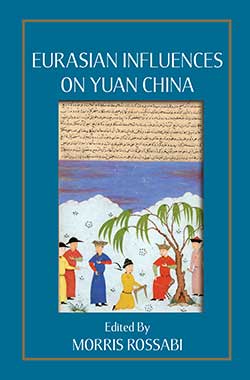Full description:
This book documents the extraordinarily significant transfers and cultural diffusion between the Mongol Yuan Dynasty of China and Central and West Asia, which had a broad impact on Eurasian history in the 13th and 14th centuries. The Yuan era witnessed perhaps the greatest inter-civilisational contacts in world history and has thus begun to attract the attention of both scholars and the general public. This volume offers tangible evidence of the Western and Central Asian influences, via the Mongols, on Chinese, and to a certain extent Korean, medicine, astronomy, navigation, and even foreign relations. Turkic peoples and other Muslims played particularly vital roles in such transmissions. These inter-civilisational relations led to the first precise Western knowledge of East and South Asia and stimulated Europeans to discover new routes to the East. The authors of these essays, specialists in their respective fields, shine a light on these vital exchanges, which anyone interested in the origins of global history will find fascinating.
CONTENTS
Preface vii Introduction by Morris Rossabi ix
Chapter 1:
Preface vii Introduction by Morris Rossabi ix
Chapter 1:
Whose Secret Intent?
George Lane
Chapter 2:
Cultural Transmission by Sea: Maritime
Trade Routes in Yuan China
John Chaffee
Chapter3:
The Conflicts between Islam and Confucianism and their Influence in the Yuan Dynasty
Ma Juan
Chapter 4:
Huihui Medicine and Medicinal Drugs in Yuan China
Angela Schottenhammer
Chapter 5:
Eurasian Impacts on the Yuan Observatory in Haocheng
Nancy S. Steinhardt
Chapter 6:
Cross-Cultural Exchange and Geographic
Knowledge of the World in Yuan China
Hyunhee Park
Chapter 7:
Some Notes on the Geographical and 159 Cartographical Impacts from Persia to China
Ralph Kauz
George Lane
Chapter 2:
Cultural Transmission by Sea: Maritime
Trade Routes in Yuan China
John Chaffee
Chapter3:
The Conflicts between Islam and Confucianism and their Influence in the Yuan Dynasty
Ma Juan
Chapter 4:
Huihui Medicine and Medicinal Drugs in Yuan China
Angela Schottenhammer
Chapter 5:
Eurasian Impacts on the Yuan Observatory in Haocheng
Nancy S. Steinhardt
Chapter 6:
Cross-Cultural Exchange and Geographic
Knowledge of the World in Yuan China
Hyunhee Park
Chapter 7:
Some Notes on the Geographical and 159 Cartographical Impacts from Persia to China
Ralph Kauz
Chapter 8:
From the Qipčaq Steppe to the Court in Daidu: A Study of the History of Toqtoq’s
Family in Yuan China
Liu Yingsheng
Family in Yuan China
Liu Yingsheng
Chapter 9: Neo-Confucian Uyghur Semuren in Koryŏ and 178 Chosŏn Korean Society and Politics
Michael C. Brose
Chapter 10: Notes on Mongol Influences on the Ming Dynasty 200
Michael C. Brose
Chapter 10: Notes on Mongol Influences on the Ming Dynasty 200
Morris Rossabi
Following is Chapter 1 from this book
Whose secret Intent?
By George Lane
Eurasian Influences On Yuan China: Cross-Cultural Transmissions in the 13th and 14th Centuries, ed. Morris Rossabi (Singapore: Univerity of Singapore Press, 2012)
Introduction: Hülegü Khan’s arrival on the south bank of the Amu Darya, or the Oxus, in the 1250s was the second time that a large Mongol-led military force had landed south of the great river poised to advance on the Iranian plateau. Three decades earlier his grandfather Chinggis Khan had unleashed his forces in a destructive campaign of retribution and conquest whereas Hülegü Khan came in response to an invitation from the Persian notables of Qazvin. He and his brothers harboured the aim of extending the mercantile, political, and cultural power of the Chinggisid empire and its emerging new dynamic reincarnation under Möngke Khan, eldest of the brothers, by consolidating their grip over the southern half of the greater Chinggisid empire encompassing Iran, Tibet, and China. A delegation from Qazvin had approached the newly enthroned emperor and requested that he extend his direct rule over the Iranian heartlands and appoint a prince to replace the ineffective and corrupt military regime, which had been in place since the early 1220s.
The Iranians had seen the rising fortunes of individual Persians and Muslims in the Chinggisid domains, and they sought to bring their land out from the cold and in from the peripheral political wastelands of the West. They sought to pre-empt any ambition that the Turanian rulers might harbour towards their land and welcome the new generation of sophisticated, worldly, and educated young princes and, as they had done so many times before, assimilate the migrants from north of the Oxus.
This paper aims to show how and why various Iranian players contributed to the assimilation and development of Il-Khanid rule in Iran. With individual notables and their families, such as Baydawi, the Iftikhariyans, and the Juwaynis, exploiting their contacts and positions, by the turn of the century the courts of the two ‘Iraqs’ were awash with linguistically adept adventurers and entrepreneurs with their gaze fixed determinedly eastward. Many had seen the hand of God in the rise of the Mongols. If God’s secret intent was promotion of the Faith, for the notables of Iran it was promotion of Persian interests.


1 comment:
This is an excellent source of information. It will be a great tool for further research. THANKS!
Post a Comment